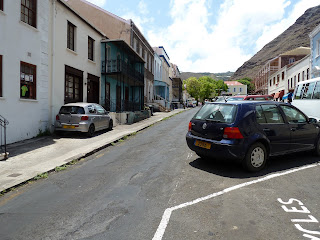Prepared January 31, 2012, South Atlantic Ocean, en route to Walvis Bay, Namibia
January 24 to 28, 2012, At sea South Atlantic Ocean, bound for St. Helena Island: All At Sea
Five continuous sea days is a long at-sea period for a cruise ship. In most cases, the ship is in port or anchored almost every second day. Probably the cruise lines don' t want the passengers to run out of things to do and get restless or bored. However, longer periods cannot be avoided when crossing the vast majority of the South Atlantic Ocean bound for Africa.
Excluding eating and sleeping, the daily routine varies from person-to-person. J & E play bridge and trivial pursuit. Other passengers take to the sun on deck chairs near the pool deck bar, and still others attend "enrichment lectures" on wide-ranging topics from astronomy to international affairs. While the younger and friskier passengers have international affairs! Anyway, everyone stays occupied, and there are very few complaints about days at sea.
The crossing from Rio to St. Helena is not a heavily-trafficked sea route. We did not see a single vessel the entire time, and any small thing, a bird or fish, causes great excitement. An example of this was the sighting of Illas Martin Vaz, an exposed rock situated along the mid-Atlantic ridge. Under normal circumstances, this rock would not have elicited as much excitement, but having not seen anything but water for two or three days, the rock became an object of great interest. The cruise director announced its sighting, and the masses rushed forth (digital cameras in hand) to photograph one of the most uninteresting rocks ever sighted by sailors. Only if you are a bird could you like this place!
 |
| Illas Martin Vaz -- Birds Wanted! |
As we began the last sea day before St. Helena, there was a noticeable increase in enthusiasm for going ashore. The cruise equivalent of rock fever had not set in, but some early symptoms were seen in the passengers' eagerness to visit a slightly larger rock on the eastern side of the South Atlantic -- St. Helena.
Sunday Morning and land ho, anchored off Jamestown, St. Helena's largest town, capital, and only port. From seaward, St Helena gives the impression of an arid island with high cliffs dropping directly into the South Atlantic. At sea level, the island is dry, but at 1,000 feet and above, it becomes a wet, semi-tropical landscape of green trees and flowers.
 |
| St. Helena and Jamestown from Seaward |
 |
| The Landscape on Top |
 |
| Jamestown and James Bay from the Top |
After several stops along the road for explanations by in-place, local guides, and opportunities for photos of Jamestown, James Bay, and the Silver Whisper, we arrive at the site where Napoleon was buried before his body was shipped to Paris and reinterred. His original tomb is about 3/4 of a mile down a grass lane from the paved road where we disembarked from the bus. The downhill walk to the tomb is a pleasant morning stroll, and the tomb itself is well maintained. All-in-all as fine a place as any to be buried.
 |
| The Sign Says It All |
 |
| Napoleon's Original Tomb Note the Flag -- Not the Union Jack! |
 |
| Got Sheep? |
 |
| Longwood House |
 |
| The Usual Suspects in Longwood House Garden Note the Matching Bags -- How Hilo Hattie! |
 | ||
Hello, My Name is Jonathan
|
Our final stop was at the top of Ladder Hill, where the upper portion of Jamestown is located 700 feet above the lower, sea-level portion. The two parts of the town were once connected by a tramway, but all that is left is the step-like concrete structure that was under the track. This forms a 699-step walkway known as Jacob's Ladder. Several of the younger guests and crew members walked down (still hobbling two days later aboard), but to our knowledge, no one walked up!
 |
| Jacob's Ladder Yes, it is a long way down! |
Finally, it was back to the Main Street of Jamestown. Even though a Sunday, all along Main Street the shops were open to celebrate the semi-annual cruise ship. However, we only had time to walk back rather quickly to the port area and tender at Wharf Steps. Returning to the Silver Whisper for lunch (no missed meals), up anchor, and sail-away to Walvis Bay, Namibia.
 |
| Main Street, Jamestown, St. Helena |
 |
| The Archway Entry to Jamestown from Port |
 |
| M/V Silver Whisper at Anchor, James Bay, St. Helena |


Oh my goodness: you guys went to St. Helena?! Our whole family is envious - but ESPECIALLY our resident Napoleon-obsessive, Katie (weird, isn't it? We have searched the world for child-appropriate books on Napoleon. She devours them!).
ReplyDeleteI'll keep reading - somehow, I never get notified of your postings - though I'm sure there's a way to get that done. But, at only (?) 43, I'm afraid I'm leagues behind the leading edge of the technological age.
Enjoy your cruise!
Sarah